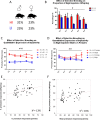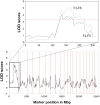Impulsivity is a heritable trait in rodents and associated with a novel quantitative trait locus on chromosome 1
- PMID: 32317713
- PMCID: PMC7174407
- DOI: 10.1038/s41598-020-63646-9
Impulsivity is a heritable trait in rodents and associated with a novel quantitative trait locus on chromosome 1
Abstract
Impulsivity describes the tendency to act prematurely without appropriate foresight and is symptomatic of a number of neuropsychiatric disorders. Although a number of genes for impulsivity have been identified, no study to date has carried out an unbiased, genome-wide approach to identify genetic markers associated with impulsivity in experimental animals. Herein we report a linkage study of a six-generational pedigree of adult rats phenotyped for one dimension of impulsivity, namely premature responding on the five-choice serial reaction time task, combined with genome wide sequencing and transcriptome analysis to identify candidate genes associated with the expression of the impulsivity trait. Premature responding was found to be heritable (h2 = 13-16%), with significant linkage (LOD 5.2) identified on chromosome 1. Fine mapping of this locus identified a number of polymorphic candidate genes, however only one, beta haemoglobin, was differentially expressed in both the founder strain and F6 generation. These findings provide novel insights into the genetic substrates and putative neurobiological mechanisms of impulsivity with broader translational relevance for impulsivity-related disorders in humans.
Conflict of interest statement
T.W.R. consults for Cambridge Cognition, Lundbeck and Mundipharma, and is currently in receipt of a research grant from Shionogi. JWD has received funding from Boehringer Ingelheim and GlaxoSmithKline. All other authors declare no conflict of interest.
Figures




References
-
- Daruna, J. & Barnes, P. in The impulsive client: theory, research and treatment (eds WG McCown, JL Johnson, & MB Shure) (American Psychological Association 1993).
Publication types
MeSH terms
Substances
Grants and funding
LinkOut - more resources
Full Text Sources

